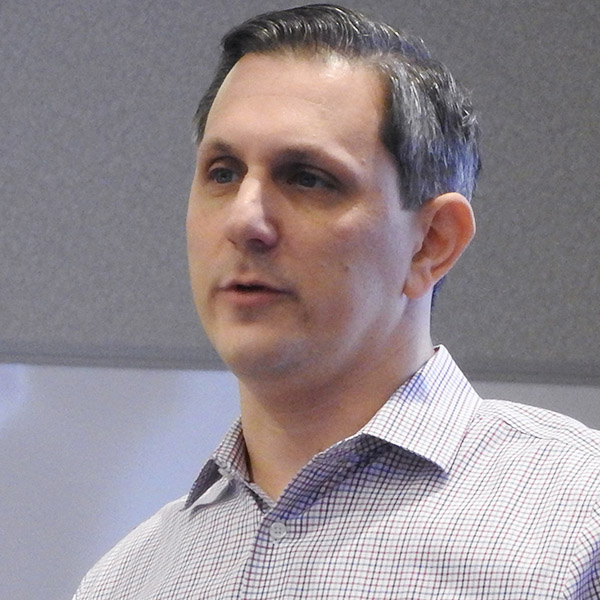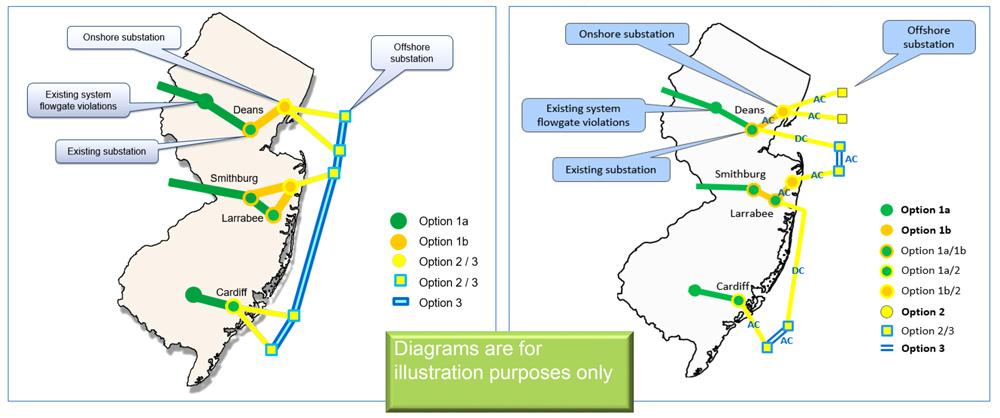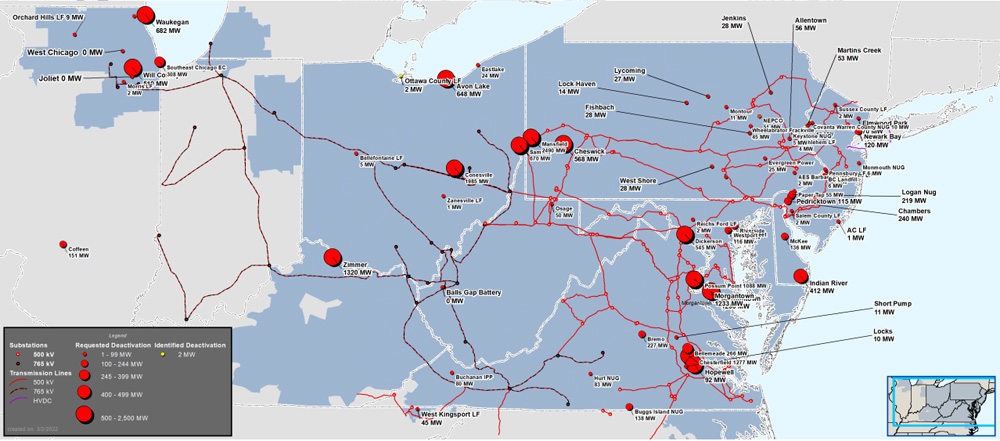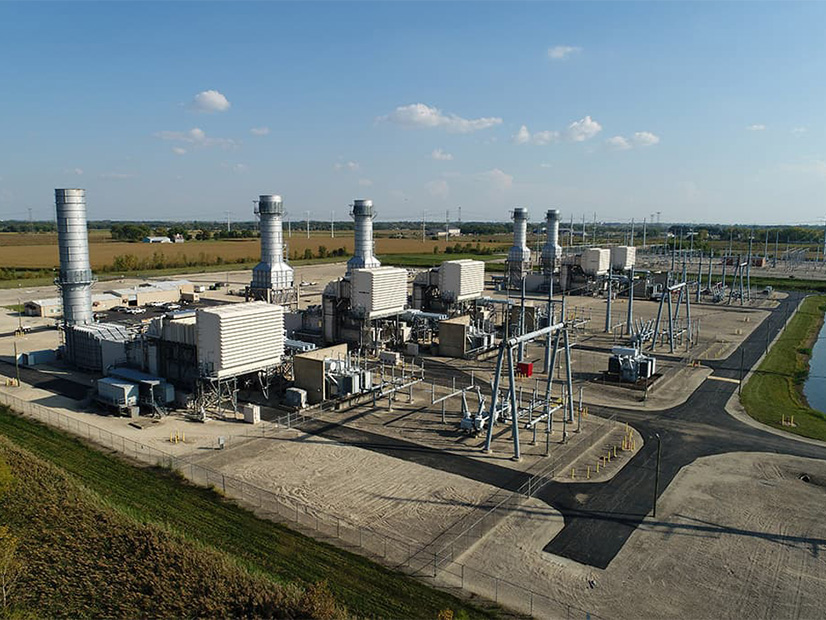Planning Committee
Deactivation Process Timing Update Endorsed
PJM stakeholders at last week’s Planning Committee meeting endorsed an update to the generation deactivation process as some members asked the RTO to slightly modify the proposed timing language.
The issue charge, developed by PJM, received 148 votes in support (99%), with two members voting against it. In a vote asking stakeholders if they preferred the proposal over maintaining the status quo, 109 (83%) favored the proposed and 22 the status quo.
David Egan, manager of PJM’s system planning modeling and support department, reviewed the proposed update, presenting the problem statement, issue charge and revisions to Manual 14D and the tariff.
The tariff currently provides 90 days advance notice and 30 days to complete deactivation studies, Egan said, causing “insufficient” time for PJM staff to determine adverse impacts on reliability if more than one deactivation notice is made in a single study period. Industry trends and state energy policies are increasing the number of deactivation notices, Egan said, putting even more pressure on staff to finish deactivation studies in a timely manner.
PJM’s issue charge calls for tariff and manual changes that “provide more time to complete analyses, allow additional and improved studies, and provide the ability for more efficient work control and consistency regarding timing of deactivation studies,” Egan said.
The proposed deactivation process would establish quarterly study times for requests, with periods beginning Jan. 1, April 1, July 1 and Oct. 1. PJM staff would study deactivations as a batch. For example, the Jan. 1 study period would result in a reliability notification at the end of February.
 PJM generation deactivation requests from June-August 2021 | PJM
PJM generation deactivation requests from June-August 2021 | PJM
Egan said the quarterly schedule would allow sufficient time for additional required seasonal, interim year and short-circuit analyses, scheduling upgrades and cost estimates. It would also allow PJM operations to identify additional needed operational measures, he said.
As a comparison to other RTOs and ISOs, Egan said MISO requires advance notice of 26 weeks for a deactivation, and the studies include 75 days to identify issues and 26 weeks to complete the deactivation study. NYISO requires advance notice of 365 days for deactivation, and studies are conducted in the subsequent quarter.
Becky Robinson, Vistra
” data-credit=”Vistra” data-id=”5401″ style=”display: block; float: none; vertical-align: top; margin: 5px auto; text-align: right; width: 200px;” alt=”Becky-Robinson-(Vistra)-FI.jpg” data-uuid=”YTAtNzkxODQ=” align=”right”>Becky Robinson, Vistra | Vistra
Becky Robinson of Vistra said she had concerns about possible upcoming actions on generation plants through EPA’s Coal Combustion Residuals Rule, which required most of the country’s 500 unlined ash pits to stop receiving waste and begin to close by April 2021. EPA began reinforcing the rule, established under President Barack Obama, this year after being targeted for rollback under President Donald Trump. (See EPA Coal Ash Enforcement Impacts Midwest Coal Plants.)
Robinson said a plant could be ordered to stop using ash pits within 135 days, effectively shutting it down and conflicting with the new deactivation timing. Resources affected by the rule have made compliance filings, she said, but EPA has yet to act on most of them, leaving the timing of their deactivation in limbo.
Paul Sotkiewicz of E-Cubed Policy Associates said he agreed with Robinson’s assessment of the EPA rulings. Other enforcement actions that can take place on a unit-specific basis through EPA or state rules don’t necessarily have well defined timelines for actions, he said.
 Paul Sotkiewicz, E-Cubed Policy Associates | © RTO Insider LLC
Paul Sotkiewicz, E-Cubed Policy Associates | © RTO Insider LLC
Sotkiewicz recommended that PJM insert tariff language that “doesn’t pin” a generator down to a specific time frame and to create exemptions if a unit is forced to deactivate through actions of EPA or states. He said a goal of the new timeline should be to avoid running afoul of EPA or state environmental agency rulings.
“I’m trying to save everybody a lot of work and heartache here by putting in some language,” Sotkiewicz said.
Dave Souder of PJM said the RTO was willing to add appropriate tariff and manual language before the update is voted on at the Markets and Reliability Committee meeting in April.
Illinois Clean Energy Jobs Act Study
Egan also updated the committee on plans for a joint PJM/MISO study on the impacts of the Illinois Climate and Equitable Jobs Act (CEJA).
Gov. J.B. Pritzker signed the legislation Sept. 15. It requires all investor-owned baseload coal-fired power plants and remaining oil peaker turbines in the state to shut down by 2030. (See Illinois Senate Passes Landmark Energy Transition Act.) Gas turbine plants, including ones currently under construction, must also close by 2045 under the terms of the bill, although the state has the option to retain plants that are critically needed.
PJM created a draft reliability guidance document to send to Illinois regarding the law and its impacts on the region. (See “Illinois CEJA Reliability Guidance Update,” PJM Operating Committee Briefs: Feb. 10, 2022.)
Egan said PJM has already identified retirement assumptions for two study periods in Illinois, with 9,905 MW impacted from the present until 2030 and 5,845 MW impacted from 2035 until 2045 for a total of 15,750 MW of generation in the state.
PJM will conduct additional sensitivity studies later this year, Egan said, with methods similar to a deactivation study using Regional Transmission Expansion Plan (RTEP) criteria for thermal and voltage studies. The RTO plans to have the study completed by July.
Egan said PJM is coordinating with MISO to conduct a study on the deactivations and have agreed to use a 2031 base case of the Multiregional Modeling Working Group (MMWG). The RTOs will model already announced generation deactivations and assumed deactivations based on the Illinois legislation. The models will also use projects in the interconnection queues for the generation replacement from deactivations.
PJM will work with the affected transmission owners for case assumptions and identifying any mitigation upgrades, schedules and costs resulting from the deactivations, Egan said.
Interconnection Subcommittee Initiative
 Jason Connell, PJM | © RTO Insider LLC
Jason Connell, PJM | © RTO Insider LLC
Jason Connell, director of infrastructure planning for PJM, discussed the possibility of forming a new subcommittee to continue discussions of interconnection process changes after work in the Interconnection Process Reform Task Force (IPRTF) finishes.
PJM’s proposal regarding the development of new rules for the interconnection process that came out of the IPRTF won near unanimous support from stakeholders at the January PC meeting. (See “New Interconnection Rules Endorsed,” PJM PC/TEAC Briefs: Jan. 11, 2022.)
Connell said PJM staff have had discussions for several weeks internally and with stakeholders about creating a new subcommittee to continue discussions on additional interconnection issues identified in the task force. PJM is working on formulating a subcommittee charter to bring to the April PC meeting for a first read. Connell said the intention is to begin holding meetings of the new subcommittee by June and establish a near-term agenda if it’s endorsed by stakeholders.
Manual 14F Update
Joseph Hay of PJM’s infrastructure coordination department provided a first read of Manual 14F: Competitive Planning Process regarding the biennial review. Hay said the review involved two main changes to the manual.
First, the critical energy/electric infrastructure information (CEII) in Manual 14F was referenced over to Manual 14B because that manual is the source document for PJM’s CEII. Hay said the change will eliminate the requirement to edit Manual 14F whenever a change is made to 14B.
The second significant update was that the Secure File Transfer Tool used to submit all proposals was replaced with a requirement to use “Competitive Planner” to submit proposals. Hay said the Secure File Transfer Tool is still available for stakeholders and will be used to submit supplemental data on an “as needed” basis.
Stakeholders will vote on the manual changes at the April PC meeting.
Manual 21A Revisions
Joshua Bruno, senior analyst in PJM’s resource adequacy planning department, provided a first read of revisions in Manual 21A: Determination of Accredited UCAP Using Effective Load Carrying Capability Analysis. The revisions are part of an effective load-carrying capability (ELCC) model run timing update and other changes to reflect the continuation of the current method of providing unit-specific backcasts only as requested.
The committee will be asked to approve an issue charge and problem statement and endorse the proposed manual revisions as part of the “quick fix” process at the April PC meeting.
PJM rules allow voluntary submission of unit-specific wind and solar parameters for development of backcasts for newer resources, Bruno said, but current manual language has an expiration date of March 1 for voluntary submissions. The submission of unit-specific parameters for all wind and solar is mandatory after the expiration date.
The alternative method is to use a zonal backcast, Bruno said, which PJM has found to be an “adequate” process.
The quick fix calls for removing the March 1 expiration date, Bruno said, which would allow PJM to continue the current practice where newer resources have the ability to elect to submit the unit-specific data or use the zonal backcast.
Bruno said another change included in the proposal is that the 2025/26 Base Residual Auction would use the December 2022 ELCC run instead of the older July 2022 run. He said the change would allow for the most recent data to be used for the when calculating the accredited unforced capacity (UCAP) for the 2025/26 BRA.
Transmission Expansion Advisory Committee
NJ Offshore Wind
Aaron Berner, PJM
” data-credit=”© RTO Insider LLC” data-id=”2480″ style=”display: block; float: none; vertical-align: top; margin: 5px auto; text-align: right; width: 200px;” alt=”Aaron Berner, PJM | © RTO Insider” data-uuid=”YTAtNTQzNTM=” align=”right”>Aaron Berner, PJM | © RTO Insider LLC
Aaron Berner, PJM manager of transmission planning, provided an update on the New Jersey offshore wind state agreement approach (SAA) proposal window at last week’s Transmission Expansion Advisory Committee meeting.
Berner said PJM has divided Option 1a, which involves onshore upgrades to existing transmission facilities, into several different geographical clusters to help in the review process. The clusters include: Northern New Jersey; Central New Jersey; Southern New Jersey; the Southern New Jersey border; and the Pennsylvania-Maryland border.
PJM is also continuing a market simulation analysis for the project combinations selected for a reliability analysis, Berner said, along with constructability and independent cost reviews of both the onshore and offshore proposals.
Berner said the New Jersey Board of Public Utilities recently posted a notice regarding a series of stakeholder meetings to collect stakeholder input on the evaluation of the transmission proposals. The first meeting takes place on March 22 with a focus on the SAA goals, the evaluation process and a review of the applications received.
 Potential solution options for offshore wind projects in New Jersey | PJM
Potential solution options for offshore wind projects in New Jersey | PJMA second meeting on March 30 deals with how the potential transmission projects will integrate with future offshore wind projects.
Generation Deactivation
Phil Yum of PJM’s system planning modeling and support department provided an update on two recent generation deactivation notifications.
 Generation deactivation requests in PJM from 2018-present | PJM
Generation deactivation requests in PJM from 2018-present | PJM
The 1.9-MW Ottawa County Landfill in Ohio’s American Transmission Systems Inc. (ATSI) transmission zone requested a deactivation date of May 31, while the 81-MW Essex 9 gas-fired generation unit in the Public Service Enterprise Group zone in New Jersey requested a deactivation date of June 1.
Yum said reliability analyses for both units are currently underway.

